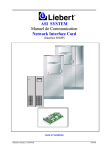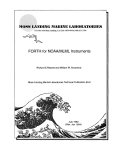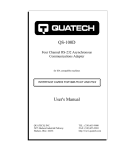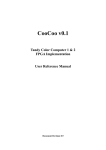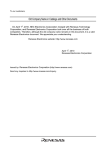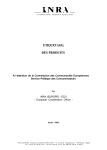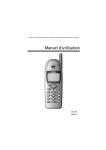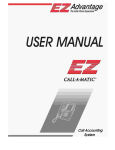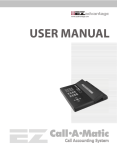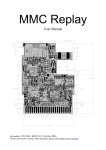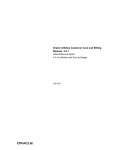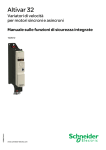Download Chameleon FPGA core development (draft version
Transcript
Turbo Chameleon 64 The Core Developers Manual Peter Wendrich [email protected] May 30, 2013 Draft version! Contents 1 Introducing the Turbo Chameleon 64 1.1 Reconfigurable hardware . . . . . . . . . . . . . . . . . . . . . . . . . . . . . . . . . 1.2 This document . . . . . . . . . . . . . . . . . . . . . . . . . . . . . . . . . . . . . . 2 2 3 2 JTAG 2.1 JTAG Boundary Scan . . . . . . . . . . . . . . . . . . . . . . . . . . . . . . . . . . 2.2 Loading a design through JTAG . . . . . . . . . . . . . . . . . . . . . . . . . . . . 3 3 5 3 I/O 3.1 3.2 3.3 3.4 3.5 3.6 3.7 3.8 3.9 3.10 3.11 3.12 3.13 mux FPGA and MUX communication DMA . . . . . . . . . . . . . . . R/W . . . . . . . . . . . . . . . . NMI, IRQ . . . . . . . . . . . . . EXROM, GAME . . . . . . . . . IOW and IOR . . . . . . . . . . . Flash-ROM CS . . . . . . . . . . RTC CS . . . . . . . . . . . . . . MMC CS . . . . . . . . . . . . . SPI MOSI, SPI CLK . . . . . . . LEDs . . . . . . . . . . . . . . . IEC . . . . . . . . . . . . . . . . PS/2 . . . . . . . . . . . . . . . . 4 FPGA I/O lines 4.1 IOe and IOf . . 4.2 ROML and ROMH 4.3 Phi-2 . . . . . . 4.4 Dot-Clock . . . 5 C64 5.1 5.2 5.3 5.4 5.5 . . . . . . . . . . . . . . . . . . . . . . . . . . . . . . . . . . . . . . . . . . . . . . . . . . . . . . . . . . . . . . . . . . . . . . . . . . . . . . . . . . . . . . . . . . . . . . . . . . . . . . . . . . . . . . . . . . . . . . . . . . . . . . . . . . . . . . . . . . . . . . . . . . . . . . . . . . . . . . . . . . . . . . . . . . . . . . . . . . . . . . . . . . . . . . . . . . . . . . . . . . . . . . . . . . . . . . . . . . . . . . . . . . . . . . . . . . . . . . . . . . . . . . . . . . . . . . . . . . . . . . . . . . . . . . . . . . . . . . . . . . . . . . . . . . . . . . . . . . . . . . . . . . . . . . . . . . . . . . . . . . . . . . . . . . . . . . . . . . . . . . . . . . . . . . . . . . . . . . . . . . . . 5 5 6 6 6 6 6 6 7 7 7 7 7 7 . . . . . . . . . . . . . . . . . . . . . . . . . . . . . . . . . . . . . . . . . . . . . . . . . . . . . . . . . . . . . . . . . . . . . . . . . . . . . . . . . . . . . . . . . . . . . . . . . . . . . . . . . . . . . . . . . . . . . . . . 7 8 8 8 8 Expansion Bus PHI2 and BA . . . . . . . . . . Implementing ROM cartridges Implementing I/O registers . . DMA and external CPUs . . . Feeding VIC-II . . . . . . . . . . . . . . . . . . . . . . . . . . . . . . . . . . . . . . . . . . . . . . . . . . . . . . . . . . . . . . . . . . . . . . . . . . . . . . . . . . . . . . . . . . . . . . . . . . . . . . . . . . . . . . . . . . . . . . . . . . . . . . . . . . . . . . . . . . . . . . . . . . . . . . . . . . 8 8 9 9 10 10 . . . . . . . . . . . . . . . . . . . . . . . . . . . . . . . . 6 Clockport 11 1 7 USB Debug interface 7.1 Commands from USB to FPGA . . . . . . . . . . . . . . . . . . . . . . . . . . . . . 7.2 Commands from FPGA to USB . . . . . . . . . . . . . . . . . . . . . . . . . . . . . 12 12 12 8 Boot Flash 12 9 PS/2 Keyboard and Mouse 9.1 PS/2 protocol . . . . . . . . . . . 9.2 Using a PS/2 keyboard . . . . . 9.2.1 PS/2 keyboard typematic 9.2.2 PS/2 keyboard scan-codes 9.3 Using a PS/2 mouse . . . . . . . 9.3.1 Mouse status packet . . . 9.3.2 Mouse movement packet . . . . . . . . . . . . . . . . . . . . . . . . . . . . . . . . . . . . . . . . . . . . . . . . . . . . . . . . . . . . . . . . . . . . . . . . . . . . . . . . . . . . . . . . . . . . . . . . . . . . . . . . . . . . . . . . . . . . . . . . . . . . . . . . . . . . . . . . . . . . . . . . . . . . . . . . . . . . . . . . . . . . . . . . . . . . . . . . . . . . . . . . . . . . . . . . . . . . . 13 13 13 14 14 15 16 16 10 IR (CDTV remote) 10.1 IR protocol . . . . 10.2 Pulse/Pause coding 10.3 Key codes . . . . . 10.4 Mouse/Joy codes . . . . . . . . . . . . . . . . . . . . . . . . . . . . . . . . . . . . . . . . . . . . . . . . . . . . . . . . . . . . . . . . . . . . . . . . . . . . . . . . . . . . . . . . . . . . . . . . . . . . . . . . . . . . . . . . . 17 17 17 17 18 11 Docking Station 11.1 Protocol . . . . . . . . . . . . . . . . . . . . . . . . . . . . . . . . . . . . . . . . . . 11.2 Amiga keyboard LEDs . . . . . . . . . . . . . . . . . . . . . . . . . . . . . . . . . . 11.3 Example code . . . . . . . . . . . . . . . . . . . . . . . . . . . . . . . . . . . . . . . 18 19 20 21 12 Using SDRAM 12.1 Rows and banks . . . . . . . 12.2 SDRAM commands . . . . . 12.3 SDRAM performing accesses 12.4 SDRAM refresh . . . . . . . . 12.4.1 SDRAM timing . . . . 12.4.2 CAS Latency . . . . . 12.4.3 Burst . . . . . . . . . 12.4.4 Byte accesses . . . . . 12.5 SDRAM clocking . . . . . . . 12.6 SDRAM initialization . . . . 12.6.1 Initialization sequence 12.6.2 Mode Register . . . . 21 21 21 22 22 22 22 22 22 23 23 23 23 . . . . . . . . . . . . . . . . . . . . . . . . . . . . . . . . . . . . . . . . . . . . . . . . . . . . . . . . . . . . . . . . . . . . . . . . . . . . . . . . . . . . . . . . . . . . . . . . . . . . . . . . . . . . . . . . . . . . . . . . . . . . . . . . . . . . . . . . . . . . . . . . . . . . . . . . . . . . . . . . . . . . . . . . . . . . . . . . . . . . . . . . . . . . . . . . . . . . . . . . . . . . . . . . . . . . 13 Pins and Signals 1 . . . . . . . . . . . . . . . . . . . . . . . . . . . . . . . . . . . . . . . . . . . . . . . . . . . . . . . . . . . . . . . . . . . . . . . . . . . . . . . . . . . . . . . . . . . . . . . . . . . . . . . . . . . . . . . . . . . . . . . . . . . . . . . . . . . . . . . . . . . . . . . . . . . . . . . . . . . . . . . . . . . . . . . . . . . . . . . . . . . . 24 Introducing the Turbo Chameleon 64 The ”Turbo Chameleon 64” is a multi-function expansion cartridge for the Commodore-64 home computer. The name is based on the multiple function aspects of the cartridge: VGA video, mass-storage, freezer and turbo. It can also emulate many classic cartridges, while providing the new functions at the same time. Some of the cartridges emulated are freezers, speeders, games and memory expansions. Finally it has a drive subsystem that emulates a complete 1541 diskdrive on a hardware level. 1.1 Reconfigurable hardware A Cyclone III FPGA chip powers most of the logic functions of the cartridge. This reconfigurable chip is the same as used on the C-One (the reconfigurable computer) expander. The Cyclone III FPGA has enough logic cells for 16 bit and even some 32 bit computer designs. A small 8 bit 2 micro on the cartridge allows the FPGA to be reloaded with new cores under software control. This makes the cartridge a rather powerfull FPGA development platform as well. The 16 MByte flash chip on the cartridge offers space for 15 user designs. Each slot is 1 MByte (1024 KByte) in size. About 370 KByte is used by the (compressed) FPGA image itself, leaving about 640 KByte free for software, ROM images and user data. 1.2 This document This document contains the technical information necessary to build new designs (cores) for the FPGA. This could be an emulation of a different home-computer, a C64 cartridge, an extra SID or a wild new core experimenting with new computer architectures. As they say ”The sky is the limit.” The information presented in this document is technical and relatively dense. It is meant as technical reference for core programmers and not a reconfigurable logic tutorial or user-manual. So some basic knowledge of digital circuits and previous experience with either VHDL or Verilog might be required to follow some of the chapters. 2 JTAG The PCB of Chameleon is prepared for a JTAG connection. This allows downloading new designs into the FPGA without flashing them first. The connection CN1 has 10 pins with a standard Altera JTAG compatible layout. Simply solder a pin-header to make the JTAG available. Pin 1 of the connector (which should match the red lead on the JTAG cable) points towards the FPGA. The side closest to the buttons are pins 9 and 10. Take note though that the JTAG connector might make it impossible to mount an ethernet card in the clock-port. 2.1 JTAG Boundary Scan There can be some surprises when performing an ”Auto Detect” in the Quartus programmer tool to intialize the JTAG chain. First there is a conflict between assigned device IDs. So the tool will request which device is actually on the board. Select the ”EP3C25” device in the popup that appears. After the chain is scanned there will appear two devices in the schematic. The first will not be recognised by Quartus by default as it is a Xilinx device. Never try to program anything into the Xilinx device! To get rid of the unknown device it is necessary to create a custom definition. Click left on the unknown device to select it. Then click right and select ”Edit” and ”Change device” in the popup menu. 3 In the requester that appears select the ”User Defined” option in the left list. Then press the ”New...” button. Enter ”CPLD” for the name. Fill in ”8” as length for the instruction register. Then press the OK button to add the new definition. Select the just added device in the list and press the OK button. This procedure only have to be done once. Quartus will remember the ID of the device and will automatically select the ”CPLD” custom definition in the future. The chain should now look similar to the picture below and the tool is ready to start programming. 4 2.2 Loading a design through JTAG TODO 3 I/O mux There are not enough I/O lines on the FPGA to control all the connectors and devices on the Chameleon. The I/O lines on the FPGA are also not 5 volt tolerant, which is necessary for interfacing to the Commodore 64 expansion port. For solving both issues, there is a CPLD on the board that performs I/O multiplexing. The MUX has some restrictions. Some signals on the expansion port are input or output only. However it is designed in such a way that it can take over the bus with DMA, but also can function as a cartridge (emulator). Some of the signal required for cartridge mode are input only and directly connected to the FPGA. This is the case for the signals like IOe and IOf and ROML and ROMH . The default and safe value for all registers is ’1’, with one exception. The signal RTC CS should be 0 when not selected. This chip has an active-high chip select instead of the usual active-low for the other SPI devices. Refer to the datasheet of the RTC component (PFC2123) for more information as it has some other issues to keep in mind, like a maximum SPI clockspeed limitation of 5 Mhz or lower (at 3.3V supply voltage). The SPI bus is shared by the startup microcontroller and the CPLD. To make sure the micro can properly start system, the FPGA must notify the CPLD that it has been startup before it will drive any chip-selects on the SPI bus. The register Ch of the MUX must be selected atleast once by the FPGA before chip-selects and SPI lines can driven by the CPLD. 3.1 FPGA and MUX communication The communication between the FPGA and the MUX uses 13 lines. The lines are unidirectional with nine of them going from FPGA to the MUX and only four lines going from the MUX to the FPGA. • 1 mux clk clock line driven by the FPGA. The CPLD clocks data on the rising edge of this clock. • 4 mux lines from the FPGA to the CPLD that select one out of 15 registers and mux states inside the CPLD. All ones (Fh ) selects no registers inside the CPLD and is therefore a safe startup/reset selection. • 4 muxd lines from the FPGA to the CPLD that contain the data clocked into one of the 15 I/O registers on next rising edge of mux clk. • 4 muxq lines from the CPLD to the FPGA with multiplexed I/O selected by mux. These outputs are not clocked and therefore need to be synchronized and deglitched inside the FPGA. The layout of the registers inside the CPLD is as follows: 5 muxd3 0h 1h 2h 3h 4h 5h 6h 7h 8h 9h Ah Bh Ch Dh Eh Fh 3.2 FPGA to MUX clocked on rising edge of mux clk muxd2 muxd1 muxd0 D3 D7 A3 A7 A11 A15 NMI A15−12 OE EXROM – – FlashROM CS USART RX IEC ATN mouse clk – D2 D6 A2 A6 A10 A14 IRQ A11−0 OE GAME – – RTC CS MMC CS IEC SRQ mouse dat – D1 D5 A1 A5 A9 A13 DMA D7−0 OE IOW – – green LED SPI MOSI IEC CLK keyb clk – MUX to FPGA D0 D4 A0 A4 A8 A12 RESET R/W IOR – – red LED SPI CLK IEC DAT keyb dat – muxq3 muxq2 muxq1 muxq0 D3 D7 A3 A7 A11 A15 NMI 1 1 1 scl IR eye 1 IEC ATN mouse clk 1 D2 D6 A2 A6 A10 A14 IRQ 1 1 1 id2 1 1 IEC SRQ mouse dat 1 D1 D5 A1 A5 A9 A13 BA BA 1 1 sda reset button 1 IEC CLK keyb clk 1 D0 D4 A0 A4 A8 A12 RESET R/W 1 1 id0 reset out 1 IEC DAT keyb dat 1 DMA When DMA is made low the CPU inside the Commodore 64 computer is stopped. This allows the Chameleon cartridge to take control over the system bus. As extra protection against core programming errors, the DMA is automatically set to low when the signal A11−0 OE is made low. The DMA line is output only. 3.3 R/W When R/W signal is low it signifies a write operation on the bus. The signal is driven together with the lower address lines A11−0 by bringing the register A11−0 OE low. When not driven the signal is input and can be read through the MUX. 3.4 NMI, IRQ The interrupt lines can be read (input) and controlled. Making the register low will pull the interrupt line low. Setting the register high will release the interrupt line. A pullup in the Commodore 64 machine will keep it at a defined state when not driven. 3.5 EXROM, GAME These two signals are output only on the MUX. They control some parts of the memory layout inside the Commodore 64 machine. Refer to the ”Commodore 64 Reference Manual” for more information about EXROM and GAME. 3.6 IOW and IOR Read and write signals for the clockport. Both are low-active signals and should both be high when the clockport is not accessed. 3.7 Flash-ROM CS This is the chip-select of the onbard flash-ROM. The line is active when low. To prevent conflicts RTC CS must be kept low and MMC CS must be kept high when selecting the flash ROM. Before this register can drive the select line, register Ch of the MUX must be selected atleast once by the FPGA. 6 3.8 RTC CS This is the chip-select of the Real Time Clock chip. This line is active when high. To prevent conflicts the lines FlashRom CS and MMC CS must be kept high when accessing the Real Time Clock. Before this register can drive the select line, register Ch of the MUX must be selected atleast once by the FPGA. 3.9 MMC CS This is the chip-select of the MMC card. This line is active when low. To prevent conflicts the lines RTC CS must be kept low and FlashRom CS must be kept high when accessing the MMC card. 3.10 SPI MOSI, SPI CLK Shared SPI data-out (MOSI) and clock lines for MMC, FlashROM and Real Time Clock. The data from the SPI devices to the FPGA (MISO) is directly connected to a FPGA input only pin and is not routed through the MUX. 3.11 LEDs The LEDs are lit when the register is 1 and are off when the register is 0. 3.12 IEC Register Dh controls the IEC bus on the Chameleon. The signals are open-collector (open-drain) and can only drive a low level. Writing a 0 in one of the IEC registers drives the corresponding line low. Writing a 1 in the register turns it into an input with a pull-up holding it high. Each IEC device should have their own pull-up resistors on the IEC lines. All signals can be input or driven low by each device on the bus. This allows multiple devices to share the same bus. The Chameleon hardware makes it possible to be the master of the bus or emulate one or even multiple devices on the IEC bus as all lines are both input and output. Due to pin limitation the Chameleon doesn’t have a reset signal on its IEC bus. So external devices might need to be reset manually. This can be done by using an optional (IEC) reset switch or by toggling the power on the device(s) that need a reset. 3.13 PS/2 Register Eh controls the PS/2 connectors on the Chameleon (located on the break-out cable). The green connector is for a PS/2 mouse and the purple connector is for a PS/2 keyboard. See chapter 9 for details about the PS/2 protocol and commands for the various devices. Example code for reading keyboard and mouse is available at http://syntiac.com/vhdl_lib. html The required download file is http://syntiac.com/zips/vhdl_io_ps2.zip 4 FPGA I/O lines As mentioned in the previous chapter. Some lines from the C64 go directly into the FPGA. This is the case for any clocklines and for some input only signals. As the FPGA isn’t 5 volt tolerant it can’t drive any C64 signals directly. So all signals that need to be output are routed through the CPLD based multiplexer. 7 4.1 IOe and IOf The lines IOe and IOf are combined into a single signal. The combined signal IOef is a logical NAND of the two select signals. It is high if any of the two I/O select lines are driven low by the C64. By inspecting the address line A8 it is possible to detect which of the two I/O spaces is actually accessed. For the docking-station this pin carries the start sequence pulse (see chapter 11). 4.2 ROML and ROMH The lines ROML and ROMH are handled similar to the IO select lines. If one of ROML or ROMH is driven low the combined signal RomLH is high and otherwise low. The address lines can be used to determine which memory area is actuallly accessed. For the docking-station this pin carries the data of the serial bitstream (see chapter 11). 4.3 Phi-2 System clock of the C64 is connected to one of the FPGA pins. Take note that the signal is inverted (phi2 n). In standalone mode the clock input is pulled high and phi2 n will always be low. If the docking-station is connected this signal is pulled low, so the FPGA pin phi2 n will be high. Observing this signal is the prefered method to detect in which hardware configuration the core runs. phi2 n Chameleon configuration Comments Toggling below 1 Mhz Toggling above 1 Mhz Low High Chameleon plugged into a PAL C64 Chameleon plugged into a NTSC C64 Standalone operation Docking-station present frequency is 0.985 Mhz frequency is 1.02 Mhz Take note that the signal has a clean high to low transition, but a slow not well defined low to high transition. Therefore the FPGA should only use the high to low transitions of the Phi-2. As signal is inverted the stable transition represents a rising-edge on the actual FPGA pin (phi2 n). 4.4 Dot-Clock The 8 Mhz pixel clock of the C64 is directly connected to one of the FPGA pins. Take note that the signal is inverted (dotclock n). For the docking-station this pin carries the clock of the serial bitstream (see chapter 11). 5 5.1 C64 Expansion Bus PHI2 and BA When the Chameleon is used as cartridge it can emulate the working of almost any other cartridge. All the control signals can be both read and driven. It can drive the datalines after requests by IOef or RomLH for data. By using the DMA line it can also stop the 6510 CPU completely and take over the bus. Combinations of these modes are possible depending on the type of cartridge to be emulated. Take note that DMA doesn’t stop the processor when it is currently writing. It will stop once the writes are complete and it tries to fetch the next opcode. Care should be taken that the correct timings are observed at all times as the VIC-II chip will also use the bus at regular intervals. The VIC-II will always drive the bus when the phi2 clock is low (input phi2 n is high). Additionally it will steal CPU cycles every eight raster lines within 8 the visible screen or when sprites are fetched. The VIC-II chip will drive the BA signal low when it needs these additional cycles from the CPU. Because of the importantce of the BA signal on the bus timing, it is located in two registers in the CPLD MUX (6h and 7h ). In both registers the BA signal is mapped to bit 1. When the BA signal goes low, the CPU (or external DMA engine) is allowed to perform upto three additional write cycles. The VIC-II will wait three cycles before it actually starts using the CPU memory cycles. This is done as workaround to the mentioned DMA bug in the 6510 processor (it can not be stopped while writes are in progress). Reading on the bus in these three cycles however is not possible as read accesses to I/O chips are blocked when BA is low. As the phi2 n input is only well defined on the rising edge (the begin of VIC-II cycle) the other transition needs to be regenerated inside the FPGA. The point of this transition can be calculated by measuring the time between two phi2 n rising edges and dividing that time in two phases. Both half phases of the clock should be about equal in length (about 500 ns each). The actual phase length differs between machines and some jitter can be expected. Use the provided chameleon phi clock entity in the support library as this is already tested to work on many machines. This entity contains some additional filtering to reduce jitter and can also detect the presence of the dockingstation. 5.2 Implementing ROM cartridges A core can could be made that turns the Chameleon into a standard ROM cartridge. It is probably the simplest possible cartridge to emulate as it doesn’t have any registers or state. First the EXROM and GAME bits in register 8h of the MUX need to be set to the proper values. When the C64 wants to read from the external ROM it will drive either ROML or ROMH low. This is captured by the FPGA pin RomLH. Take note that this pin is the result of a NAND function of the ROML and ROMH signals, so it normally low and becomes high on any ROM access. Once the RomLH goes high the address lines should be read from the CPLD MUX. Then a memory access (to blockram) is started and the read data put into the data latches in the MUX. Then the data output enable (D7−0 OE) is made low until the RomLH signal becomes low again. It is not necessary to follow any clocks or keep track of the phi2 phase. The control logic in the C64 will take care of all the necessary timing. We are emulating a simple EPROM cartridge without any additional logic here. Simple eprom cartridges of 8K and 16K can be emulated this way. The FPGA has 66 KByte of blockram so that will fit easily. A more fancy emulation could store upto four 16K cartridges (or eight 8K cartridges) in the FPGA. One of the blue buttons could be used to toggle the EXROM and GAME bits to turn the ROM(s) on and off. It is adviced to build a simple ROM cartridge emulation like that to gain experience with the MUX and the C64 expansion bus, before attempting to build more complex designs. 5.3 Implementing I/O registers The concept is similar to the ROM cartridge emulation explained in the previous chapter. However the signal to trigger on is now IOef. Next to reading the address lines it is also necessary to check the R/W flag. It will tell the core if the data output enable flag (D7−0 OE) must be set or not. The simple test core could map 512 bytes of blockram into DE00h -DFFFh . Again as in the ROM case the C64 will take care of all the timing. However the IOef signal might be glitchy on some older machines. A small filter that waits a few clock cycles in the FPGA before accepting it as active can fix that. Again it is adviced to build a core like that to gain experience with the MUX and the C64 expansion bus. 9 5.4 DMA and external CPUs To perform any form of DMA or take over the function of the CPU it is essential to have a stable clock. Use the provided chameleon phi clock entity to filter and regenerate the phi2 clock. To drive the bus it is necessary to control both the databus and the address bus output-enable bits. The R/W signal will be driven together with the address bus. The address bus has two output-enables. One for the lower twelve address lines and the other for the upper four. For addressing the bus and doing any type of DMA, both should be set to the same value. Setting the output-enable bits low will drive the address lines onto the expansion bus. This is only allowed during the CPU half of the PHI2 cycle (when PHI2 is high) and only when the BA signal is high. Driving the address lines at any other time will conflict with the VIC-II chip. This is definitely not a desired situation. As mentioned before it is possible to perform upto three write cycles while BA is already low. Often the extra complexity to support this quirk in the FPGA logic is not worth it for the very small performance improvement (75 cycles out of 19657 per frame on a PAL machine). Although the clock speed in the FPGA can be 100 times faster as the C64 clock, the expansion bus timing is still tricky. The communication with the CPLD MUX goes through only 4 data pins (in each direction). So to transfer both address, data and control infomation to the MUX takes multiple FPGA cycles. The real challenge however is on the C64 side. The various chips inside the machine each have their own setup and hold timings. They require the data and address busses to be stable at different times within the cycle. For sending data to the C64 the datalines should be stable as early as possible and should stay driven slightly into the next half-cycle. When reading from the C64 the data should be taken over as late as possible, but definitely before the end of the cycle. The CIAs take over data at the very begin of the cycle. The main memory chips (DRAM) are very slow and can have access times upto around 300 ns. The color-ram is SRAM (static RAM) and wants to see stable data from the beginning until late in the cycle. The Kernal and BASIC ROMs can be fast (EPROM) to very very slow (400ns+ or almost a full cycle in case of the original SX-64 Kernal ROM chip). The VIC-II has multiple sample points and can best be treated the same as the SRAM (give data fast and keep it stable). This can be a challenge as often video data will be coming from SDRAM which takes time. The main Chameleon core has three points in the cycle where data is transfered. At the very beginning of the cycle for (emulated) CPU writes to CIA, SID and VIC-II registers. Somewhere half-way the cycle after SDRAM reads are complete to feed the VIC-II chip character or sprite data. The actual spot in the schedule is a comprimise between SDRAM speed and VIC-II setup time. And finally at the very end just before the cycle ends for reads from ROMs and I/O space. The most stable way to perform I/O is to start at a memory location. First set the data and the lowest twelve address lines to proper values and set the upper four address lines initially to Ch . Then set the output-enables. Wait a few cycles (40 ns?) and change the Ch into a Dh . That way all the chips will see stable data and addresses before being addressed. The thing that makes it complex is that fact that next to the tricky timing explained above, the MUX must perform other functions as well. The IEC bus must be updated with regular intervals, the PS/2 mouse and keyboard pins need to be read and driven. And finally talking to the MMC card means updating the SPI signals 16 times within a C64 cycle (For 8 Mbit/s or one byte per C64 cycle). 5.5 Feeding VIC-II The Chameleon cartridge uses a trick to display the same picture on both the VGA and the VIC-II chip. The VIC-II is fed data from the memory inside the Chameleon except for the color information in color RAM. To do this the Chameleon makes use of an undocumented feature of the PLA logic chip inside the C64. Certain combinations of the upper four address lines together with ultimax mode (GAME is low, EXROM is high) allow the internal memory to be disabled during VIC-II accesses. 10 The VIC-II chip can only address 16 KByte directly. The lines A14 and A15 come from a CIA chip during VIC-II cycles so it can reach all 64K of memory. However only the lower 12 bits of the address lines on the expansion bus are driven (see the C64 schematics). The lowest eight are captured by a LS373 buffer from the multiplexed address outputs (that drive the memory chips). Additionally the VIC has dedicated outputs for bits A8 to A11 to complete the address of the character ROM and color RAM. The upper four bits (two from the VIC and two from the CIA) take various routes through multiplexers and the PLA chip, but never drive the expansion bus. Four pullup resistors keep the address lines A12 to A15 high during VIC-II cycles. As the upper four lines are only held high with pullups, an external cartridge (like the Chameleon) can pull them low. This is only allowed during VIC-II cycles. Certain combinations of the upper addresses will disable memory and character ROM accesses, but only when GAME is driven low as well (Ultimax mode). The VIC-II will then access ”open space”. Then the Chameleon is allowed to drive the databus and feed the VIC-II directly. This makes it possible to completely change the memory layout the VIC-II sees and is the trick behind the turbo CPU function. This is the reason there are two output-enable signals in the MUX for the address bus. One for the upper four and one for the lower 12 lines. Take note that the Commodore 128 behaves differently on this point and is the main reason Chameleon is not compatible with this machine. The following table shows the possible combinations and the effect on the addressing of the VIC-II chip. GAME EXROM A15 A14 A13 A12 VIC-II accesses 0 0 0 0 0 0 0 0 0 0 0 0 0 0 0 0 1 1 1 1 1 1 1 1 1 1 1 1 1 1 1 1 0 0 0 0 0 0 0 0 1 1 1 1 1 1 1 1 0 0 0 0 1 1 1 1 0 0 0 0 1 1 1 1 0 0 1 1 0 0 1 1 0 0 1 1 0 0 1 1 0 1 0 1 0 1 0 1 0 1 0 1 0 1 0 1 Memory and Open space Open space Open space Open space Open space Open space Open space Memory and Memory and Open space Open space Open space Memory and Memory and Memory and x 1 0 x x x x x x x x x Memory and ROM Memory and ROM 6 ROM ROM ROM ROM ROM ROM Clockport The clockport has separate control signals, but shares the address and databus with the expansion port. Therefore the clockport should only be addressed in open address space so there is no data conflict. The logical address range for this is DE00h –DFFFh . Making the clockport visible in this address range for the C64 CPU is easy. When the IOef signal is high the CPU reads or writes in the IO areas. The R/W signal determines if the IOW or IOR signal on the clockport needs to be activated. Accessing the clockport from the Chameleon side (CPU is stopped with DMA) still requires accessing in the range DE00h –DFFFh . Not all address lines are needed for the clockport itself, but it makes sure that the C64 is not driving the databus at the same time as the pheripheral on the clockport. This is only important in cartridge mode ofcourse, but it is recommended to always drive the bus in this way. 11 7 USB Debug interface The USB microcontroller and FPGA communicate over a synchronous serial bus. The microcontroller generates the bit clock (at about 2 Mhz). Sample the data when clock line is high (or on the rising edge) and change data when clock is low (or on the falling edge). The data format is 9 bits with no parity. If the highest bit is set it is a command, otherwise it is a databyte. The FPGA must inform the microcontroller of its existence by sending the command 12Ah after startup. The microcontoller will respond with the flash slot number used during configuration (110h –11Fh ). Using the slotnumber the FPGA can now load additional data from the flash-chip from the correct location. Take note that the FPGA receives data from the microcontroller directly on I/O pins (including the synchronous clock). The line for transmission towards the microcontroller however runs through the CPLD multiplexer. Make sure the register is updated at 4 MHz or faster to ensure proper transmission of data. The serial transmission bit is combined with the SPI lines that are updated 16 times per C64 cycle (which is around 1 usec) in the Chameleon core. This allows for an 8 Mbit transfer rate on the SPI bus and is also fast enough to have stable synchronous serial communication with the micro. 7.1 Commands from USB to FPGA Command Action Additional bytes 100h 101h 102h 110h –11Fh Stop Write Read Slot number A31−24 A31−24 7.2 A23−16 A23−16 A15−8 A15−8 A7−0 A7−0 bytes ... Len23−16 Len7−0 Commands from FPGA to USB Command Action 12Ah 1F0h –1FFh I’m here Reconfigure request. Lowest four bits contain slot number. 8 100h Len15−8 Boot Flash The boot flash can store upto sixteen different FPGA designs (cores). After powerup the system tries to start from slot 0. If that fails the next slot is tried. If all sixteen slots have failed to start the FPGA, the red LED will start flashing. The other slots can be used by either using Chaco tool to select the slot or by giving a reconfig command from the FPGA side. See the chapter ”USB Debug Interface” how to communicate with the microcontroller to request a reconfig. The flash size is 16 MByte total, so each slot is 1 MByte. A binary image for the Cyclone III FPGA is in the 300 to 350 KByte range. This leaves about 600 KByte free for storage of firmware or other data. The FPGA binary image sizes can slightly differ depending on the design, so a fixed offset from the beginning is not possible. So there must be an another way to know where the data starts. For this each flash slot starts with three bytes that tells the size of the FPGA binary image. These bytes are written by the Chaco tool when a new core is flashed. The first of the three bytes contains the upper 8 bits of the size, the second byte contains the middle part and the last byte contains the lowest 8 bits. Ofcourse only the first 19 bits of the size can ever be set to 1, all the upper bits will always be 0. This information can be used as an extra check to see if the offset value is valid. After the three size bytes follows the FPGA image itself and then the data. To get the absolute position of the data in the flash requires adding the 12 slot address (in bits 23–20) to the size. So by reading the first 3 bytes and then adding the start address of the slot, the result is the absolute address of the data in the flash. As the upper bits will always be zero the slot number can also be ”or”-ed in, as that is often easier to implement. 9 PS/2 Keyboard and Mouse The PS/2 is an open-collector (or open-drain) bus with pull-up resistors. This allows both the host (computer) and the device (mouse or keyboard) to send and receive data. Only zeros drive the pin low and ones let it float (and turn the pin into an input). The pull-up resistors make sure that a pin is high when nothing pulls it low. 9.1 PS/2 protocol Each byte on the interface is transmitted LSB first in a frame of 11 or 12 bits. The clock line during frame transfer is always generated by the device (keyboard or mouse) at 10 to 17 Khz. When transfering data from device to the host the data line changes when clock is high and is read by the host when the clock line is low. When transfering data from the host to the device the data line changes when the clock is low and is read by the device when the clock is high. The acknowledge bit is send by the device so the data line is pulled low on ack by the device when the clock is high. Then one more clock pulse is generated by the device and the transfer is finished. bit purpose 1 2 3-8 9 10 11 12 start bit, always 0 LSB of byte bits 1 to 6 MSB of byte parity bit (odd parity) stop bit, always 1 acknowledge bit (host to device communication only) The parity bit is 1 if there is a even number of ones in the byte to be send and 0 if there is a odd number of ones in the byte. The total ones in the parity and 8 data bits together is therefore always an odd number (that is why it is called odd parity). If the host wants to send something to the device it pulls clock low for atleast 100 microseconds. This request can happen at any time even during frame transfer. After the 100 microseconds the data line is pulled low and the clock line is released, this is the begin of the start bit. 9.2 Using a PS/2 keyboard For every key pressed the keyboard, it sends one or more scan-codes to the host. Sending data to the keyboard is necessary when you want to change one of the LEDs for Num-Lock, Caps-Lock or Scroll-Lock. Also the repeat rate (and delay before repeating) can be modified by sending commands to the keyboard. After each byte is send from the host, the keyboard responds with FAh . 13 byte command comments EDh Set/Reset LEDs EEh F3h Echo Set typematic rate F4h F5h F6h Enable Disable Set Defaults FEh FFh Resend Reset This command takes one argument byte bit0 Scroll-Lock LED (0=off, 1=on) bit1 Num-Lock LED (0=off, 1=on) bit2 Caps-Lock LED (0=off, 1=on) bit7..3 should be set to 0 Keyboard responds with EEh Set key-repeat rate and delay before repeat starts. This command takes one argument byte (see next table). Enable keyboard (after it was disabled with F6h ) Disables scanning and loads defaults Load default settings (10.9cps / 500ms key repeat) and selects scancode set 2 Last byte is resend Load default settings and performs a self-test. Keyboard sends 0xAA after self-test completes or FCh when there is an error. 9.2.1 PS/2 keyboard typematic Following table show the bit allocations of the argument byte for the F3h command. bits4..0 Rate (cps) bits4..0 Rate (cps) bits4..0 Rate (cps) bits4..0 Rate (cps) bits6..5 delay 00h 01h 02h 03h 04h 05h 06h 07h 30.0 26.7 24.0 21.8 20.0 18.5 17.1 16.0 08h 09h 0Ah 0Bh 0Ch 0Dh 0Eh 0Fh 15.0 13.3 12.0 10.9 10.0 9.2 8.6 8.0 10h 11h 12h 13h 14h 15h 16h 17h 7.5 6.7 6.0 5.5 5.0 4.6 4.3 4.0 18h 19h 1Ah 1Bh 1Ch 1Dh 1Eh 1Fh 3.7 3.3 3.0 2.7 2.5 2.3 2.1 2.0 00 01 10 11 250 ms 500 ms 750 ms 1 second 9.2.2 bit 7 should be 0 PS/2 keyboard scan-codes There are three different scancode sets that can be configured on PS/2 keyboards. The first set is for XT compatibility. The following tables describe the scancode set 2, which is the default set on all PS/2 keyboards. The third scancode set is almost never used and is therefore not described in this document. 14 key make break key make break key make break A B C D E F G H I J K L M N O P Q R S T U V W X Y Z ;: ’” ,< . > 1Ch 32h 21h 23h 24h 2Bh 34h 33h 43h 3Bh 42h 4Bh 3Ah 31h 44h 4Dh 15h 2Dh 1Bh 2Ch 3Ch 2Ah 1Dh 22h 35h 1Ah 4Ch 52h 41h 49h F0h F0h F0h F0h F0h F0h F0h F0h F0h F0h F0h F0h F0h F0h F0h F0h F0h F0h F0h F0h F0h F0h F0h F0h F0h F0h F0h F0h F0h F0h Esc F1 F2 F3 F4 F5 F6 F7 F8 F9 F10 F11 F12 0 1 2 3 4 5 6 7 8 9 ‘˜ = \ [{ ]} /? 76h 05h 06h 04h 0Ch 03h 0Bh 83h 0Ah 01h 09h 78h 07h 45h 16h 1Eh 26h 25h 2Eh 36h 3Dh 3Eh 46h 0Eh 4Eh 55h 5Dh 54h 5Bh 4Ah F0h F0h F0h F0h F0h F0h F0h F0h F0h F0h F0h F0h F0h F0h F0h F0h F0h F0h F0h F0h F0h F0h F0h F0h F0h F0h F0h F0h F0h F0h Space Enter BkSp Tab Caps L Shift L Ctrl L Win L Alt R Shift R Ctrl R Win R Alt Apps Num KP 0 KP 1 KP 2 KP 3 KP 4 KP 5 KP 6 KP 7 KP 8 KP 9 KP . KP / KP * KP KP + KP Enter 29h 5Ah 66h 0Dh 58h 12h 14h E0h 11h 59h E0h E0h E0h E0h 77h 70h 69h 72h 7Ah 6Bh 73h 74h 6Ch 75h 7Dh 71h E0h 7Ch 7Bh 79h 6Bh F0h F0h F0h F0h F0h F0h F0h E0h F0h F0h E0h E0h E0h E0h F0h F0h F0h F0h F0h F0h F0h F0h F0h F0h F0h F0h E0h F0h F0h F0h F0h 1Ch 32h 21h 23h 24h 2Bh 34h 33h 43h 3Bh 42h 4Bh 3Ah 31h 44h 4Dh 15h 2Dh 1Bh 2Ch 3Ch 2Ah 1Dh 22h 35h 1Ah 4Ch 52h 41h 49h 76h 05h 06h 04h 0Ch 03h 0Bh 83h 0Ah 01h 09h 78h 07h 45h 16h 1Eh 26h 25h 2Eh 36h 3Dh 3Eh 46h 0Eh 4Eh 55h 5Dh 54h 5Bh 4Ah 1Fh 14h 27h 11h 2Fh 4Ah key make break Print Screen Scroll Pause Power Sleep Wake up Insert Delete Home End Page Up Page Down Up Left Down Right E0h 7Eh E1h E0h E0h E0h E0h E0h E0h E0h E0h E0h E0h E0h E0h E0h E0h F0h 7Ch E0h F0h 12h F0h 7Eh – (no break code!) E0h F0h 37h E0h F0h 3Fh E0h F0h 5Eh E0h F0h 70h E0h F0h 71h E0h F0h 6Ch E0h F0h 69h E0h F0h 7Dh E0h F0h 7Ah E0h F0h 75h E0h F0h 6Bh E0h F0h 72h E0h F0h 74h 9.3 12h E0h 7Ch 14h 77h E1h F0h 14h F0h 77h 37h 3Fh 5Eh 70h 71h 6Ch 69h 7Dh 7Ah 75h 6Bh 72h 74h 29h 5Ah 66h 0Dh 58h 12h 14h F0h 11h 59h F0h F0h F0h F0h 77h 70h 69h 72h 7Ah 6Bh 73h 74h 6Ch 75h 7Dh 71h F0h 7Ch 7Bh 79h 6Bh 1Fh 14h 27h 11h 2Fh 4Ah Using a PS/2 mouse The mouse sends its data in packets. Such a packet is standard three bytes in size. However after reprogramming (with something called a knocking sequence) some mice can also transmit four or 15 five byte long packets. These extra bytes can give information about the scroll-wheel and extra buttons on the mouse. Here only the standard 3 byte protcol is described. Before the mouse sends any data to the host it needs to be in stream mode with data reporting enabled. The two commands EAh and F4h can be used to switch the mouse in this mode. However if the current state of the mouse is unknown it might be better to send the reset command FFh first. After reset the mouse is already in stream mode so sending the EAh command is unnecessary. The host should wait for the self-test complete (AAh ) and ID (00h ) response codes before sending any additional commands. byte command comments E6h Set scaling 1:1 E7h Set scaling 1:2 E9h Status Request EAh Set Stream Mode EBh Read Data F0h Set Remote Mode F4h Enable Data Reporting F5h Disable Data Reporting F6h FEh FFh Load Defaults Resend Reset Default scaling. No processing is done on the X and Y deltas. Alternate scaling value. Some processing is done on the X and Y deltas, which inplements speed dependent scaling. Mouse responds with FAh followed by a status packet. (See chapter 9.3.1) Mouse responds with FAh , resets its counters and enters stream mode. Request a movement packet. Mouse responds with FAh followed by a movement packet. (See chapter 9.3.2) Mouse responds with FAh , resets its counters and enters remote mode. Mouse acknowledges with FAh and starts sending packets when mouse is moved or buttons are pressed. Mouse acknowledges with FAh and stops transmitting movement data. Load default values into the mouse. Request mouse to resend last data packet. Moused responds with FAh and resets. After reset it send AAh (self-test complete) and its ID (normally 00h ). If the mouse detects an problem during self-test it responds with FCh instead of AAh . 9.3.1 Mouse status packet The following packet is send when requested with command E9h . Byte 1 Bit 7 Bit 6 Bit 5 Bit 4 Bit 3 Bit 2 Bit 1 Bit 0 always 0 Mode Enable Scaling always 0 Left Button Middle Button Right Button Byte 2 Resolution Byte 3 Sample Rate L,M,R Buttons is 1=button pressed and 0=not pressed. Scaling is 1=scaling 2:1, 0=scaling 1:1 Enable is 1=Data Reporing Enabled, 0=Data Reporting Disabled Mode is 1=Remote Mode, 0=Stream Mode 9.3.2 Mouse movement packet The following packet is send when the mouse is moved and data reporting is enabled (command F4h ) or when it is requested with command EBh . 16 Byte 1 Bit 7 Bit 6 Bit 5 Bit 4 Bit 3 Bit 2 Bit 1 Bit 0 Y overflow X overflow Y sign bit X sign bit always ’1’ Middle Button Right Button Left Button Byte 2 X Movement Byte 3 Y Movement L,M,R Buttons is 1=button pressed and 0=not pressed. 10 IR (CDTV remote) The Chameleon has a IR-eye designed (40 Khz) for an Amiga CDTV remote. The IR-eye already does filtering of the received signal. So the FPGA will receive a clean digital signal and doesn’t have to do much signal processing itself. The signal comes through the CPLD. The IR data is bit 3 in register Bh . The IR data signal is high (1) at rest. When infrared is detected on 40 Khz the IR data signal goes low (0). 10.1 IR protocol The IR remote encodes the keypresses in 12 bits. These are send twice, the second time inverted, to verify the correct reception of the code. Holding a key doesn’t send the key again, but sends a special repeat code. Release of keys are not communicated and must be determined by a timeout (neither new keycode or repeat code send in certain period). The recommended timeout is 110 milliseconds. A compromise between reliable repeat detection and release response. The IR-eye is really sensitive for 40 Khz so missed keys don’t happen often. 10.2 Pulse/Pause coding Each new code starts with a pulse (IR=0) of 9 milliseconds. The keycode is send as short (380 usec) or long (1180 usec) pauses (IR=1) followed by a pulse of 420 usec (IR=0) somewhat like morse-code. The first 12 pauses (short and long) are the actual code and are repeated with short and long swapped for verification. The key hold is different and after the 9 millisecond start pulse is a pause of 2.1 milliseconds followed by a pulse of 420 usec. The repeat codes are send approximately every 60 milliseconds as long as the key(s) stay pressed. If no valid code or repeat code is received after 110 milliseconds, any pressed key(s) must be assumed released. 10.3 Key codes The following table only lists the first 12 pause pairs. The second 12 are the inverse of the first 12. The S is short pause and the L is the long pause. The pauses are grouped in 3 blocks of 4 for easier reading. 17 Key Code 1 2 3 4 5 6 7 8 9 0 escape enter genlock cd/tv power rew play/pause ff stop vol up vol down SSSS SSSS SSSS SSSS SSSS SSSS SSSS SSSS SSSS SSSS SSSS SSSS SSSS SSSS SSSS SSSS SSSS SSSS SSSS SSSS SSSS 10.4 SSSS SSSL SSLS SSSL SSSL SSSL SSSS LSSL SSLS LSSL SSSL LSSL SSSS SLSL SSLS SLSL SSSL SLSL SSLL LSSL SSLL SSSL SSLL SLSL SSLS SSLS SSSS SSLS SSSL SSLS SSLL SSLS SSSS LSLS SSSL LSLS SSLS LSLS SSSS SLLS SSLL LSLS Mouse/Joy codes For the Mouse or Joystick multiple buttons can be active at the same time. Each button will make a specific pause long (L). With multiple buttons pressed, multiple pauses will be changed from S to L. As example ”Mouse A+B” is given. The codes SSSS LSSS SSSS and SSSS SLSS SSSS combine into SSSS LLSS SSSS. Button Code Mouse A Mouse B Mouse A+B Mouse Up Mouse Down Mouse Left Mouse Right Joy A Joy B Joy Up Joy Down Joy Left Joy Right SSSS LSSS SSSS SSSS SLSS SSSS SSSS LLSS SSSS SSSS SSLS SSSS SSSS SSSL SSSS SSSS SSSS LSSS SSSS SSSS SLSS LSSS LSSS SSSS LSSS SLSS SSSS LSSS SSLS SSSS LSSS SSSL SSSS LSSS SSSS LSSS LSSS SSSS SLSS 11 Docking Station The docking-station adds four joystick connectors and two different keyboard connectors to the Chameleon. This supports the system with more flexibility and options when running in standlone mode. The docking-station is driven by a 8051 style micro-controller from STC. The firmware in the micro-controller performs some pre-processing and scanning without support of the FPGA. For example the docking-station will scan the eight columns of C64 keyboard autonomously. It also decodes the data-stream from the Amiga keyboard including the handling of data acknowledge and retransmissions. The FPGA will receive the pre-decoded data as a fixed sequence of octets (bytes). 18 11.1 Protocol The docking-station transfers all data in a sequence of 13 octets. The data is transfered using a synchronous serial port. Before the sequence starts it pulses the word signal low for a few microseconds. The word signal is connected to IOe/IOf and IRQ line on the Chameleon. The IOe/IOf are directly connected to the FPGA allowing fast response. The IRQ line is used to send pulses back to the docking-station to control LEDs on an Amiga keyboard. Take note that the IOe/IOf lines come in inverted on the FPGA. The data comes in on the ROM-L/H lines with the LSB first. Take note that the combined ROM-L/H line is inverted on the FPGA pin. The clock is connected to dotclock n (again inverted). The data is output by the docking-station on the falling edge, so the data should be captured by the FPGA on the rising edge. As the dotclock n input is inverted this sample point is a falling-edge on the actual FPGA pin. See the following table for the purpose of each of the thirteen octets send by the docking-station. 19 Byte Status Scancode C64 C64 C64 C64 C64 C64 C64 C64 P0 P1 P2 11.2 col0 col1 col2 col3 col4 col5 col6 col7 bits purpose 0 1 2 3–7 0–6 7 0 1 2 3–7 8–14 15 0–7 0–7 0–7 0–7 0–7 0–7 0–7 0–7 0 1 2 3 4 5 6 7 0 1 2 3 4 5 6 7 0 1 2 3 4 5 6 7 16–23 24–31 32–39 40–47 48–55 56–63 64–71 72–79 80 81 82 83 84 85 86 87 88 89 90 91 92 93 94 95 96 97 98 99 100 101 102 103 Set if Amiga keyboard has send scancode C64 Restore status (low active) Amiga reset line status (low active) Reserved for future use (always 0) Scancode of Amiga keyboard Key make and break flag. Bit is clear on make and set on break/release. Status of row lines when column 0 is low Status of row lines when column 1 is low Status of row lines when column 2 is low Status of row lines when column 3 is low Status of row lines when column 4 is low Status of row lines when column 5 is low Status of row lines when column 6 is low Status of row lines when column 7 is low Joystick 2 Up Joystick 2 Down Joystick 2 Left Joystick 2 Right Joystick 2 Fire Button Joystick 2 Second Fire Button Joystick 4 Second Fire Button / Joystick 2 Third Fire Button Joystick 4 Fire Button Joystick 4 Right Joystick 4 Left Joystick 4 Down Joystick 4 Up Joystick 3 Right Joystick 3 Left Joystick 3 Down Joystick 3 Up Joystick 1 Up Joystick 1 Down Joystick 1 Left Joystick 1 Right Button Joystick 1 Fire Button Joystick 1 Second Fire Button Joystick 3 Second Fire Button / Joystick 1 Third Fire Button Joystick 3 Fire Amiga keyboard LEDs The docking-station can control the two LEDs on the Amiga keyboard. For this the word signal is used. The word signal is sampled between bits 47 and 48 and if high the Power LED is lit. The word signal is also sampled between bits 79 and 80 and if high the Drive LED is lit. As the word signal is driven by both the docking-station controller and the Chameleon it should be open-collector/drain output. For this reason the word signal is connected to the IRQ line on the Chameleon edge connector. As the word signal is only weakly pulled-up there is an extra ”pull high” action sixteen bit-clocks after sampling the word signal (after sending bit 64 and bit 96). The Chameleon should switch the IRQ high before this time as not to pull with the IRQ signal against the micro-controller. It is recommended to set the word signal eight clocks before the sample period and release it eight clocks after the sample time. This makes sure the setup and hold times are correct and the release time not critically close to the ”pull high” time. For the receiving side the word signal should be ignored in the bit-clock range 32 to 96 as not 20 trigger on the word signal while driven low to control the LEDs. The logic inside Chameleon should be in sync with the micro-controller (atleast seen and acted on one word-signal) before pulling the IRQ low. This again to guard against the Chameleon pulling low while the micro-controller pulses high. 11.3 Example code Example code in VHDL for using the docking-station is included in the Chameleon hardware test version 2. The required download file is http://syntiac.com/zips/chameleon_hwtest2.zip 12 Using SDRAM The SDRAM on Chameleon is 32 MByte in size. It is organized as four banks of 4 million words, each 16 bits wide. The signals sd lqdm and sd uqdm allow the selection of only the lower or upper 8 bits in the 16 bits word. 12.1 Rows and banks The four banks in the memory operate almost completely independed and can be in different states. Each bank is split into rows. Before a read or write operation can be performed the specific row needs to be activated. Activating a row copies the content of the cells into an output buffer stage. In this process the original state of the cells is lost. After activation of a row, reading and writing can be performed on any column inside the row. When the updates and reads on the row are complete, the row needs to be closed again. This process is called pre-charging and that action copies the contents in the output stage amplifiers back into the row cells. After the pre-charge a different row can be activated on that bank. The closing of rows can be done in two different ways. There is a precharge command that closes one or all banks. And a bank can be set to auto-precharge mode when a read or write command is issued. With auto-precharge enabled, the precharge is performed while reading the actual data and that can save time when many read accesses are performed in sequence from different rows or banks. When performing autorefresh cycles all banks need to be closed (pre-charged). It is not possible to just autorefresh a single bank. The command works on all banks at the same time. 12.2 SDRAM commands Commands are given to the SDRAM by using a combination of the RAS, CAS and WE signals. Any commands that work on a single bank need the bank bits set to the proper bank when the command is given. Command BA1−0 A10 No Operation Set Mode Register Auto Refresh x x Bank Activate Precharge Bank Precharge All <bank> <bank> x Write Write and Auto-precharge Read Read and Auto-precharge A12−11,9−0 RAS CAS WE H L L H L L H L H <row address> L x H x L L L H H H H L L <bank> <bank> L H <column address> <column address> H H L L L L <bank> <bank> L H <column address> <column address> H H L L H H x x <mode register bits> x x 21 12.3 SDRAM performing accesses To perform a read or write the proper row needs to be openend. This is done through the ”activate” command by driving the RAS signal low. The bank and address pins should have the proper values. This command takes an additional cycle to complete (unless the clock frequency is very low) so the next command should be a NOP. After the row has been openend read and write instructions can be given on that row. The read and write also need the bank and address lines to be valid. Take note that A10 has a special meaning when giving read and write commands. It determines if the row needs to be closed automatically (auto-precharge) after the command completes. For writes the datalines should contain the first valid word (or byte) and additional words must be given on the next cycles until the burst is complete. For read the data will arrive on the data pins after a number of cycles given by the CAS latency. The CAS latency depends on the clock speed (2 for anything lower as 133 Mhz and 3 above that). After the reading and writing is complete the row can be closed by a ”precharge” command, unless an ”auto-precharge” was given that automatically closes the row. It is possible to close a specific bank or all banks at the same time. 12.4 SDRAM refresh The charge in the RAM cells will leak slowly away. To prevent data loss all cells need to be periodically (every 64 msecs) read and rewritten. This can be done by reading the proper address sequence every 64 msecs. However the SDRAM can do this automatically. This is called ’autorefresh’. The SDRAM will refresh one internal row for every autorefresh cycle. For the SDRAM used on the Chameleon the autorefresh command has to be executed a minimum of 4096 times every 64 msecs. The timing within a 64 msecs interval is not critical as long as 4096 autorefreshes are completed within that time. It is required that all rows are closed (pre-charged) before an autorefresh command is given. 12.4.1 SDRAM timing TODO 12.4.2 CAS Latency The CAS latency is the number of clocks that are between setting the read address and the SDRAM providing data. The CAS latency represents the time that the SDRAM can use to read the correct data from its memory cells. As the CAS latency is specified in a number of clock ticks, the value depends on the used clock frequency. For the SDRAM as used on Chameleon, a CAS latency of 2 is possible for clock frequencies up to 133 Mhz. For clock frequency higher as 133 Mhz the CAS latency need to be set to 3. 12.4.3 Burst Reading single bytes or words from memory is slow as a lot of time is wasted with opening a row and waiting for the CAS latency. To increase the effective bandwidth the SDRAM can run in burst mode. This transfers multiple words from consecutive addresses for a single read or write operation. 12.4.4 Byte accesses TODO 22 12.5 SDRAM clocking Because SDRAM is synchronous it needs a clock to operate. The signal sd clk output on the FPGA must be used to provide the SDRAM with a clock. The SDRAM takes over data on a low to high transition of the clock. So the basic idea is to provide or change data on high to low transition and sample on low to high transition of the clock. This is true for both the SDRAM and the FPGA. However there is a certain time delay between the FPGA generating the clock and the SDRAM receiving it. Using a delayed (or phase-shifted) clock signal as SDRAM clock can help improve the speed and stability of the communication. A good starting point is a 180 degree phase shift. The sd clk should be the inverse of the system clock, when the FPGA uses logic that operates on a rising edge. If logic is used that reacts on the falling edge, the sd clk must be made equal to the system clock. Use the the PLLs of the Cyclone FPGA for generating the clock. It can implement the 180 degree phase shift very accurately. This methode is preferred over using an inverter. The logic gate would introduce jitter and additional delays. 12.6 SDRAM initialization Before the SDRAM can be used it needs to be properly initialized. This requires a sequence of steps, all of which are mandatory. Fortunately this sequence is fairly standard, so the same intialization code will work with almost any type of SDRAM. 12.6.1 Initialization sequence The initialization sequence is as follows: • Send NOP for about 20 microseconds. This allows time for the clocks to stabilize. • Precharge all banks • Perform a few autorefresh cycles • Set mode register • Perform 10 NOP cycles (only a few are necessary) 12.6.2 Mode Register Before the SDRAM can be used the mode register needs to be set to proper values. Only 2 settings are really important, the rest of the mode bits can normally be set to zero. The timing of the SDRAM is set with the CAS Latency setting, allowable values are 2 or 3 clocks. Also the correct burst length needs to be configured. The following table shows how the bits in the mode register needs to be configured for specific SDRAM settings. Bit combinations not mentioned in the table should not be used as these are reserved for use in newer SDRAM devices. BA1 0 BA0 0 A12 0 A11 0 A10 0 A9 0 A8 0 A7 0 CAS Latency, 2 clocks CAS Latency, 3 clocks A6 A5 A4 CAS Latency 0 0 1 1 Burst type sequential Burst type interleave A3 BT 0 1 0 1 Burst length 1 Burst length 2 Burst length 4 Burst length 8 Full page sequential 23 A2 A1 A0 Burst Length 0 0 0 0 1 0 0 1 1 1 0 1 0 1 1 13 Pins and Signals Overview of the chip I/O pins and their function. Most the FPGA pins are connected to other chips on the PCB. Communication with the C64 expansion connector, IEC bus and PS/2 connectors goes through the CPLD. Clocks Name FPGA CPLD C64 25 87 44 88 89 – 27 – – – – – – E 6 Name FPGA CPLD C64 Reset IRQ NMI – – – 74 17 99 C 4 D clk8 mux clk sd clk phi2 n dotclock n comments 8 Mhz system clock. CPLD clock generated by FPGA. SDRAM clock C64 system clock (inverted) C64 pixel clock (inverted) Interrupts comments System reset C64 expansion connector Name SD[0] SD[1] SD[2] SD[3] SD[4] SD[5] SD[6] SD[7] SA[0] SA[1] SA[2] SA[3] SA[4] SA[5] SA[6] SA[7] SA[8] SA[9] SA[10] SA[11] SA[12] SA[13] SA[14] SA[15] SRW GAME EXROM BA DMA IOef RomLH FPGA CPLD C64 – – – – – – – – – – – – – – – – – – – – – – – – – – – – – 90 91 97 95 92 89 87 85 82 81 96 86 91 90 79 78 82 81 1 6 8 9 10 12 14 15 16 13 11 4 3 – – 21 20 19 18 17 16 15 14 Y X W V U T S R P N M L K J H F 5 8 9 12 13 7 / 10 11 / B comments C64 data line 0 C64 data line 1 C64 data line 2 C64 data line 3 C64 data line 4 C64 data line 5 C64 data line 6 C64 data line 7 C64 address line 0 C64 address line 1 C64 address line 2 C64 address line 3 C64 address line 4 C64 address line 5 C64 address line 6 C64 address line 7 C64 address line 8 C64 address line 9 C64 address line 10 C64 address line 11 C64 address line 12 C64 address line 13 C64 address line 14 C64 address line 15 C64 R/W line (0=write, 1=read) GAME line EXROM line BA line DMA line C64 IOe and IOf (ANDed together and inverted) C64 ROML and ROMH (ANDed together and inverted) FPGA to CPLD connection Name FPGA CPLD C64 comments 24 mux clk mux[0] mux[1] mux[2] mux[3] mux d[0] mux d[1] mux d[2] mux d[3] mux q[0] mux q[1] mux q[2] mux q[3] 87 119 115 114 113 125 121 120 132 126 127 128 129 27 60 61 63 64 56 58 59 50 55 54 53 52 – – – – – – – – – – – – – CPLD clock generated by FPGA CPLD register selection (bit 0) CPLD register selection (bit 1) CPLD register selection (bit 2) CPLD register selection (bit 3) Data bit 0 from FPGA to CPLD Data bit 1 from FPGA to CPLD Data bit 2 from FPGA to CPLD Data bit 3 from FPGA to CPLD Data bit 0 from CPLD to FPGA Data bit 1 from CPLD to FPGA Data bit 2 from CPLD to FPGA Data bit 3 from CPLD to FPGA SDRAM connection Name sd sd sd sd sd sd sd sd sd sd sd sd sd sd sd sd sd sd sd sd sd sd sd sd sd sd sd sd sd sd sd sd sd sd sd sd sd clk ras n cas n we n ba 0 ba 1 ldqm udqm data[0] data[1] data[2] data[3] data[4] data[5] data[6] data[7] data[8] data[9] data[10] data[11] data[12] data[13] data[14] data[15] addr[0] addr[1] addr[2] addr[3] addr[4] addr[5] addr[6] addr[7] addr[8] addr[9] addr[10] addr[11] addr[12] FPGA CPLD C64 44 43 46 50 39 143 51 49 83 80 79 71 68 66 64 59 58 60 65 67 69 72 77 76 4 6 32 30 7 8 10 11 28 31 144 33 42 – – – – – – – – – – – – – – – – – – – – – – – – – – – – – – – – – – – – – – – – – – – – – – – – – – – – – – – – – – – – – – – – – – – – – – – – – – FPGA CPLD C64 comments SDRAM clock Row address select Column address select Write enable Bank select bit 0 Bank select bit 1 Lower byte select (for sd data[7..0] Upper byte select (for sd data[15..8] Audio Name comments 25 sigmaL sigmaR 86 85 – – – – Left audio output Right audio output VGA connector Name FPGA CPLD C64 red[0] red[1] red[2] red[3] red[4] grn[0] grn[1] grn[2] grn[3] grn[4] blu[0] blu[1] blu[2] blu[3] blu[4] 111 110 106 105 104 103 101 100 99 98 112 133 135 136 137 – – – – – – – – – – – – – – – – – – – – – – – – – – – – – – comments 26


























